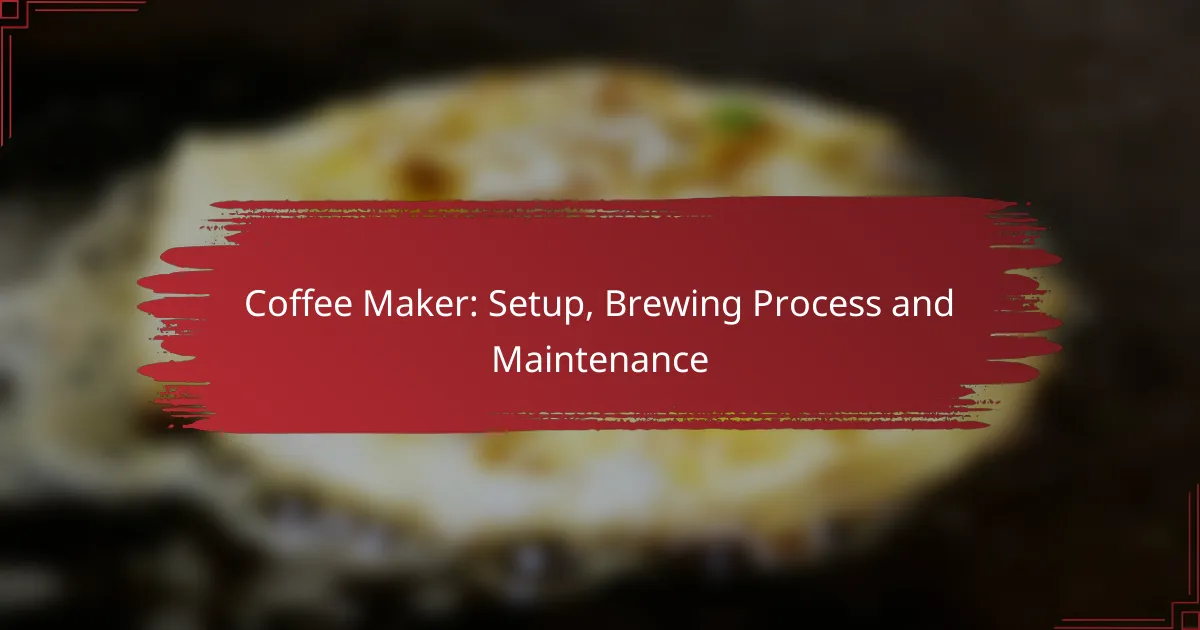Setting up a coffee maker correctly is crucial for achieving the best flavor and performance from your machine. The brewing process involves extracting rich flavors from coffee grounds, influenced by factors such as water temperature and brew time. Regular maintenance, including cleaning and descaling, is essential to prolong the life of your coffee maker and enhance your coffee experience.

How to set up a coffee maker?
Setting up a coffee maker involves a few straightforward steps that ensure optimal performance and flavor. Proper setup can enhance your brewing experience and extend the life of your machine.
Step-by-step setup for Keurig K-Elite
To set up the Keurig K-Elite, start by removing all packaging materials and placing the machine on a flat, stable surface. Fill the water reservoir with fresh water, ensuring it is securely attached to the machine.
Next, plug in the coffee maker and power it on. Run a cleansing brew without a coffee pod by selecting the largest cup size, which helps to clean the internal components. Once this is done, you can insert your preferred coffee pod and begin brewing.
Initial setup for Breville BES870XL
For the Breville BES870XL, begin by unpacking the machine and placing it on a level countertop. Fill the water tank with fresh water and ensure it is properly seated in the machine.
Next, turn on the machine and allow it to heat up, which typically takes a few minutes. After the machine is ready, you can grind your coffee beans using the built-in grinder, adjust the grind size, and brew your first cup. Make sure to calibrate the settings according to your taste preferences.
Common setup mistakes to avoid
One common mistake is not thoroughly cleaning the coffee maker before the first use. Always run a cleansing cycle to remove any manufacturing residues. Additionally, avoid using hard water, as it can lead to mineral buildup and affect the taste of your coffee.
Another pitfall is not properly measuring the water-to-coffee ratio. For most coffee makers, a general guideline is to use about 1 to 2 tablespoons of coffee per 6 ounces of water, but this can vary based on personal preference. Always refer to the manufacturer’s instructions for specific recommendations.

What is the brewing process for coffee makers?
The brewing process for coffee makers involves extracting flavors from coffee grounds using hot water. Different methods yield distinct flavors and strengths, influenced by variables like water temperature, brew time, and coffee grind size.
Brewing method for drip coffee makers
Drip coffee makers work by heating water and dripping it over coffee grounds contained in a filter. The water absorbs flavors and oils as it passes through the grounds and drips into a carafe below. Typical brew times range from 4 to 6 minutes, and a common ratio is about 1 to 2 tablespoons of coffee per 6 ounces of water.
To ensure optimal flavor, use fresh, coarsely ground coffee and clean your machine regularly to prevent buildup. Avoid using water that is too hot, as it can lead to over-extraction and bitterness.
Brewing process for French press
The French press brewing process involves steeping coarsely ground coffee in hot water for several minutes before pressing down a metal or plastic plunger to separate the grounds from the liquid. A typical steeping time is around 4 minutes, and a common ratio is 1 to 2 tablespoons of coffee per 6 ounces of water.
For best results, use water just off the boil and ensure the coffee is evenly saturated. Avoid steeping for too long to prevent a bitter taste, and clean the press thoroughly after each use to maintain flavor integrity.
Espresso extraction techniques
Espresso extraction requires finely ground coffee and high pressure, typically around 9 bars, to force hot water through the grounds. The process usually takes about 25 to 30 seconds, producing a concentrated shot of coffee with a rich crema on top. A standard ratio is 18 to 20 grams of coffee for a double shot.
Key factors for successful espresso include using fresh coffee, maintaining consistent grind size, and ensuring proper tamping. Regular maintenance of the espresso machine is crucial to prevent clogs and ensure optimal extraction quality.

How to maintain a coffee maker?
Maintaining a coffee maker is essential for ensuring optimal performance and longevity. Regular cleaning and descaling can enhance the flavor of your coffee and prevent buildup that affects functionality.
Cleaning tips for Mr. Coffee machines
For Mr. Coffee machines, start by unplugging the unit and allowing it to cool. Remove any used coffee grounds and wash the brew basket and carafe with warm, soapy water. Rinse thoroughly to eliminate soap residue.
Periodically, run a mixture of equal parts water and white vinegar through the brewing cycle to clean the internal components. Follow this with a couple of cycles of plain water to flush out any vinegar taste.
Descaling process for Nespresso machines
Descaling a Nespresso machine is crucial to prevent mineral buildup. Use a Nespresso descaling solution or a mixture of water and citric acid. Fill the water tank with the solution and start the descaling mode, following the manufacturer’s instructions.
After the descaling process, run several cycles of fresh water through the machine to ensure all descaling solution is removed. This process should be done every few months, depending on water hardness.
Maintenance schedule for coffee makers
Establishing a maintenance schedule can help keep your coffee maker in top shape. Clean removable parts after each use, and perform a deep clean every month. Descale your machine every three to six months, depending on usage and water quality.
Additionally, check the coffee maker’s power cord and plug regularly for any signs of wear or damage. Keeping a log of maintenance activities can help track when each task was last completed, ensuring nothing is overlooked.

What are the best coffee maker brands?
The best coffee maker brands are known for their reliability, quality, and innovative features. Cuisinart, Hamilton Beach, and Technivorm consistently receive high ratings from consumers and experts alike for their performance and design.
Top-rated coffee makers from Cuisinart
Cuisinart offers a variety of coffee makers that cater to different brewing preferences, including single-serve and traditional drip models. Their machines often feature programmable settings, allowing users to customize brew strength and temperature.
Popular models include the Cuisinart DCC-3200, which boasts a 14-cup capacity and a brew-pause feature, and the Cuisinart SS-10, a single-serve machine compatible with K-Cups. Both models are praised for their ease of use and consistent coffee quality.
Popular models from Hamilton Beach
Hamilton Beach is recognized for its budget-friendly coffee makers that do not compromise on quality. Their models often include unique features such as a built-in grinder and a thermal carafe for better heat retention.
The Hamilton Beach FlexBrew is a standout, allowing users to brew a full pot or a single cup, making it versatile for households with varying coffee needs. Additionally, the Hamilton Beach 46310 is noted for its simple operation and affordability.
Best features of Technivorm coffee makers
Technivorm coffee makers are celebrated for their high-quality construction and exceptional brewing consistency. They are handmade in the Netherlands and are known for meeting strict European brewing standards.
Key features include precise temperature control, a unique brewing process that ensures optimal extraction, and a sleek design. Models like the Technivorm Cup-One and the Technivorm KBT are particularly favored for their ability to brew coffee quickly while maintaining rich flavor.

How to troubleshoot common coffee maker issues?
Troubleshooting common coffee maker issues involves identifying the problem and applying straightforward solutions. Many issues can be resolved with simple adjustments or maintenance steps.
Fixing a coffee maker that won’t brew
If your coffee maker won’t brew, start by checking the power source. Ensure the machine is plugged in and the outlet is functioning properly. If the power is fine, inspect the water reservoir for adequate water levels.
Next, clean the machine, focusing on the brew basket and filter area. Coffee grounds can clog these parts, preventing proper brewing. Run a cycle with a mixture of water and vinegar to clear any buildup.
Resolving water leakage problems
Water leakage can stem from a few common issues, such as a worn-out seal or improperly placed carafe. First, check the carafe for cracks and ensure it is seated correctly on the warming plate.
If the seal is damaged, consider replacing it. Regular maintenance, including cleaning the water reservoir and checking for blockages, can prevent leaks from occurring in the first place.
Addressing weak coffee extraction
Weak coffee extraction often results from insufficient coffee grounds or improper brewing time. To enhance flavor, use the recommended coffee-to-water ratio, typically around 1 to 2 tablespoons of coffee per 6 ounces of water.
Additionally, ensure the coffee is fresh and ground to the appropriate coarseness for your brewing method. If using a drip coffee maker, a medium grind is usually best. Experiment with brewing times to find the optimal strength for your taste preferences.

What are the differences between coffee maker types?
Different types of coffee makers vary in their brewing methods, convenience, and flavor profiles. Understanding these differences helps you choose the right machine for your coffee preferences and lifestyle.
Drip Coffee Makers
Drip coffee makers are among the most common types, using a simple process where water is heated and then dripped over ground coffee in a filter. They typically brew multiple cups at once, making them ideal for households or offices.
When selecting a drip coffee maker, consider features like programmable settings, built-in grinders, and thermal carafes. These features can enhance convenience and maintain coffee temperature for longer periods.
Single-Serve Coffee Makers
Single-serve coffee makers, often using pods, offer a quick and convenient way to brew a single cup of coffee. They are perfect for individuals who want a fresh cup without the hassle of measuring and brewing larger quantities.
While single-serve machines are easy to use, they may have higher per-cup costs due to the price of coffee pods. Additionally, consider the environmental impact of single-use pods and explore reusable options if sustainability is a concern.
Espresso Machines
Espresso machines create concentrated coffee by forcing hot water through finely-ground coffee under pressure. They are favored by coffee enthusiasts who enjoy rich, bold flavors and the ability to make various coffee drinks like lattes and cappuccinos.
Investing in an espresso machine requires understanding the different types, such as manual, semi-automatic, and fully automatic. Each type offers varying levels of control and complexity, so choose one that matches your skill level and desired coffee experience.
French Press
The French press, or press pot, is a manual brewing method that allows coffee grounds to steep in hot water before being separated by pressing down a metal or plastic plunger. This method produces a full-bodied coffee with a rich flavor.
To use a French press effectively, use coarsely ground coffee and steep for about four minutes. Be mindful of the coffee-to-water ratio, typically around 1:15, to achieve the desired strength without bitterness.
Aeropress
The Aeropress is a portable brewing device that uses air pressure to push hot water through coffee grounds, resulting in a smooth and concentrated coffee. It’s compact and easy to clean, making it a great option for travel or small kitchens.
Experiment with different grind sizes and brewing times to find your preferred flavor profile. The Aeropress is versatile, allowing for various brewing styles, including espresso-like shots and cold brews.
Cold Brew Makers
Cold brew makers steep coarsely ground coffee in cold water for an extended period, usually 12 to 24 hours. This method produces a smooth, less acidic coffee that can be served over ice or mixed with milk.
When making cold brew, a common ratio is 1:4 coffee to water. After steeping, strain the mixture through a filter or mesh to remove grounds. Cold brew can be stored in the refrigerator for up to two weeks, making it convenient for busy mornings.


